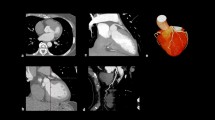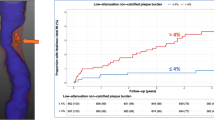Abstract
This study aimed to prospectively evaluate delayed enhancement imaging by spectral computed tomography using soluble iodine containing contrast media to improve the in vivo characterization of coronary plaque types based on the quantification of delayed iodine enhancement. Patients with known or suspected coronary artery disease (CAD) underwent spectral coronary CT-angiography (SCCTA). Absolute delayed iodine enhancement in all visible coronary plaques was assessed. Patients with significant CAD (> 50% stenosis) further underwent invasive coronary angiography (ICA) including optical coherence tomography (OCT). We identified 50 non-calcified coronary plaques in 72 patients undergoing SCCTA. 17 patients with significant CAD underwent further ICA including OCT imaging. In those, we were able to match 35 plaques by both SCCTA and OCT. Based on OCT imaging, 22/35 matched plaques (63%) were characterized as high-risk coronary plaques (thin-cap fibroatheroma n = 2, fibroatheroma n = 20), whereas 13/35 (37%) were characterized as low-risk plaques (fibrocalcific lesion n = 3, fibrous plaques n = 9, and early-onset fibroatheroma n = 1). All plaques showed similar HU’s and could not be classified into high-risk or low-risk plaques by conventional CT measures. Minimal delayed iodine enhancement within plaques as quantified by SCCTA demonstrated significantly lower values in high-risk as compared to low-risk coronary plaques (1.0 ± 1.5 mg/ml vs. 2.2 ± 1.1 mg/ml, p = 0.021) which allowed estimation of high-risk plaques with high sensitivity and moderate specificity (77% and 56%). Measurement of delayed enhancement iodine uptake within stable coronary artery plaques using dual-layer SCCTA might contribute to a more precise estimation of plaque vulnerability surpassing conventional CT techniques.



Similar content being viewed by others
References
Members TF et al (2013) 2013 ESC guidelines on the management of stable coronary artery disease: the task force on the management of stable coronary artery disease of the European Society of Cardiology. Eur Heart J 34(38):2949–3003
Fihn SD et al (2012) 2012 ACCF/AHA/ACP/AATS/PCNA/SCAI/STS guideline for the diagnosis and management of patients with stable ischemic heart disease: a report of the American college of cardiology foundation/American heart association task force on practice guidelines, and the American college of physicians, American association for thoracic surgery, preventive cardiovascular nurses association, society for cardiovascular angiography and interventions, and society of thoracic surgeons. J Am Coll Cardiol 60(24):e44–e164
Motoyama S et al (2009) Computed tomographic angiography characteristics of atherosclerotic plaques subsequently resulting in acute coronary syndrome. J Am Coll Cardiol 54(1):49–57
Fujimoto S et al (2012) Delayed plaque enhancement by CT angiography. JACC Cardiovasc Imaging 5(11):1181–1182
Motoyama S et al (2015) Plaque characterization by coronary computed tomography angiography and the likelihood of acute coronary events in mid-term follow-up. J Am Coll Cardiol 66(4):337–346
Virmani R et al (2006) Pathology of the vulnerable plaque. J Am Coll Cardiol 47(8):C13–C18
Kolodgie F, Gold HK, Burke AP, Fowler DR, Kruth HS, Weber DK, Farb A, Guerrero LJ, Hayase M, Kutys R, Narula J, Finn AV, Virmani R (2003) Intraplaque hemorrhage and progression of coronary atheroma. New Engl J Med 349:2316–2325
Johnson TR et al (2007) Material differentiation by dual energy CT: initial experience. Eur Radiol 17(6):1510–1517
Amsterdam EA et al (2014) 2014 AHA/ACC guideline for the management of patients with non-ST-elevation acute coronary syndromes: a report of the american college of cardiology/american heart association task force on practice guidelines. Circulation 130(25):e344–e426
Tearney GJ et al (2012) Consensus standards for acquisition, measurement, and reporting of intravascular optical coherence tomography studies: a report from the international working group for intravascular optical coherence tomography standardization and validation. J Am Coll Cardiol 59(12):1058–1072
Miller JM et al (2008) Diagnostic performance of coronary angiography by 64-row CT. N Engl J Med 359(22):2324–2336
Kosmala A et al (2019) Radiation dose of coronary CT angiography with a third-generation dual-source CT in a “real-world” patient population. Eur Radiol 29(8):4341–4348
Motoyama S et al (2007) Multislice computed tomographic characteristics of coronary lesions in acute coronary syndromes. J Am Coll Cardiol 50(4):319–326
Cho I et al (2018) Prognostic value of coronary computed tomographic angiography findings in asymptomatic individuals: a 6-year follow-up from the prospective multicentre international confirm study. Eur Heart J 39(11):934–941
Braunwald E (2015) Progress in the noninvasive detection of high-risk coronary plaques. J Am Coll Cardiol 66(4):347–349
Yahagi K et al (2016) Pathophysiology of native coronary, vein graft, and in-stent atherosclerosis. Nat Rev Cardiol 13(2):79–98
Nerlekar N et al (2018) Computed tomographic coronary angiography–derived plaque characteristics predict major adverse cardiovascular events: a systematic review and meta-analysis. Circ Cardiovasc Imaging 11(1):e006973
Narula J et al (2013) Histopathologic characteristics of atherosclerotic coronary disease and implications of the findings for the invasive and noninvasive detection of vulnerable plaques. J Am Coll Cardiol 61(10):1041–1051
McCollough CH et al (2015) Dual-and multi-energy CT: principles, technical approaches, and clinical applications. Radiology 276(3):637–653
Schoepf UJ, Colletti PM (2012) New dimensions in imaging: the awakening of dual-energy CT. Am J Roentgenol 199:S1–S2
Rajiah P, Abbara S, Halliburton SS (2017) Spectral detector CT for cardiovascular applications. Diagn Interv Radiol 23(3):187
Lorusso V et al (1994) Pharmacokinetics and tissue distribution of iomeprol in animals. Eur J Radiol 18:S13–S20
Ibrahim T et al (2009) Serial contrast-enhanced cardiac magnetic resonance imaging demonstrates regression of hyperenhancement within the coronary artery wall in patients after acute myocardial infarction. JACC Cardiovasc Imaging 2(5):580–588
Eisen A, Giugliano RP, Braunwald E (2016) Updates on acute coronary syndrome: a review. JAMA Cardiol 1(6):718–730
Casscells W, Naghavi M, Willerson JT (2003) Vulnerable atherosclerotic plaque: a multifocal disease. Circulation 107(16):2072–2075
Nadjiri J et al (2016) Incremental prognostic value of quantitative plaque assessment in coronary CT angiography during 5 years of follow up. J Cardiovasc Comput Tomogr 10(2):97–104
Meding J et al (2007) Magnetic resonance imaging of atherosclerosis by targeting extracellular matrix deposition with gadofluorine M. Contrast Media Mol Imaging 2(3):120–129
Libby P (2000) Changing concepts of atherogenesis. J Intern Med 247(3):349–358
Funding
The authors declare that no funds, Grants, or other support were received during the preparation of this manuscript.
Author information
Authors and Affiliations
Contributions
All authors contributed to the study conception and design. JN and TK contributed equally to this work. Material preparation, data collection acquisition, interpretation of data and analysis were performed by JN, TK, AK, FW, MR, FGG, CES, DP, K-LL, MRM and TI. The first draft of the manuscript was written by JN and TK, and all authors commented on previous versions of the manuscript. All authors read and approved the final manuscript for publication. All authors agree to be accountable for all aspects of the work in ensuring that questions related to the accuracy or integrity of any part of the work are appropriately investigated and resolved.
Corresponding author
Ethics declarations
Conflict of interest
Tobias Koppara received horonaria from Abbott Medical GmbH, Germany. All other authors have nothing to disclose.
Ethical approval
This study was performed in line with the principles of the Declaration of Helsinki. Approval was granted by the Ethics Committee of the Technical University of Munich (11/2018; no: 38/18 s).
Consent to participate
Informed consent was obtained from all individual participants included in the study.
Additional information
Publisher's Note
Springer Nature remains neutral with regard to jurisdictional claims in published maps and institutional affiliations.
Rights and permissions
About this article
Cite this article
Nadjiri, J., Koppara, T., Kafka, A. et al. Coronary plaque characterization assessed by delayed enhancement dual-layer spectral CT angiography and optical coherence tomography. Int J Cardiovasc Imaging 38, 2491–2500 (2022). https://doi.org/10.1007/s10554-022-02638-4
Received:
Accepted:
Published:
Issue Date:
DOI: https://doi.org/10.1007/s10554-022-02638-4




